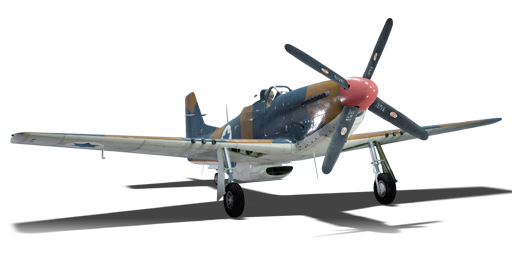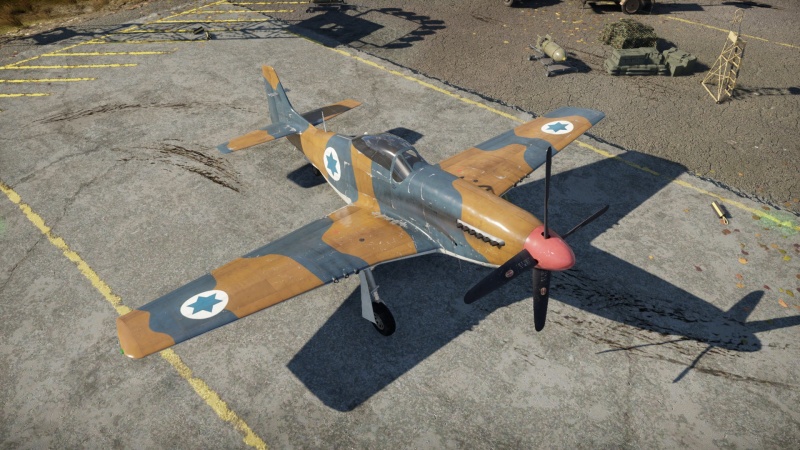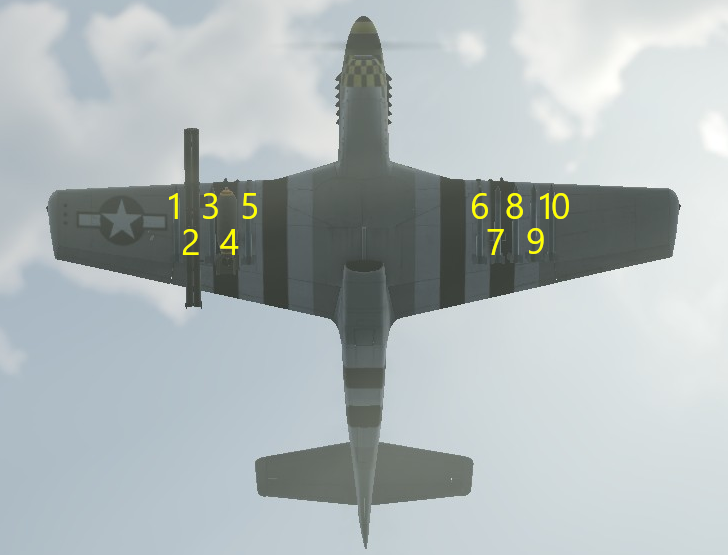P-51D-20-NA (Israel)
| This page is about the fighter P-51D-20-NA (Israel). For other versions, see P-51 (Family). |
Contents
Description
The P-51D was acquired by Israel in 1948 by secret agents trying to smuggle aircraft into Israel bypassing the US embargo. Some units managed to be sent to Israel and were crucial in the Independence War. These P-51s were the backbone of the IAF, thanks to its long range and multirole capabilities. They were used in escort, reconnaissance, patrol, and close air support missions, finally being retired from duty in 1961.
Introduced in Update "Winged Lions", the P-51D-20 excels at being fast and high. Even when stock, it has excellent cruise speed and acceleration. It lacks the agility of other dogfighters, but it's decent in defensive manoeuvres, while also carrying a very large ammo pool with good ammunition to set enemy planes on fire. It also features good ground attack capabilities making it an amazing multirole fighter.
General info
Flight performance
Mustangs are known for being fast aircraft. This is its most important characteristic. While it has decent agility, it is outclassed by many other planes, and it may be hard to control the nose of the plane when going at speeds over 650 km/h. Acceleration is also great and the engine is not prone to overheating like in other props of its BR.
| Characteristics | Max Speed (km/h at 7,620 m) |
Max altitude (metres) |
Turn time (seconds) |
Rate of climb (metres/second) |
Take-off run (metres) | |||
|---|---|---|---|---|---|---|---|---|
| AB | RB | AB | RB | AB | RB | |||
| Stock | 685 | 668 | 12700 | 23.0 | 23.8 | 15.7 | 15.7 | 396 |
| Upgraded | 735 | 710 | 21.0 | 22.0 | 22.8 | 18.9 | ||
Details
| Features | ||||
|---|---|---|---|---|
| Combat flaps | Take-off flaps | Landing flaps | Air brakes | Arrestor gear |
| ✓ | ✓ | ✓ | X | X |
| Limits | ||||||
|---|---|---|---|---|---|---|
| Wings (km/h) | Gear (km/h) | Flaps (km/h) | Max Static G | |||
| Combat | Take-off | Landing | + | - | ||
| 901 | 281 | 644 | 512 | 265 | ~11 | ~5 |
| Optimal velocities (km/h) | |||
|---|---|---|---|
| Ailerons | Rudder | Elevators | Radiator |
| < 500 | < 300 | < 500 | > 400 |
Survivability and armour
While not the biggest target in the battlefield, the P-51D-20 is quite large for a fighter, and it also has a big engine. This makes going in head-ons highly deadly, since a few shots in the engine will make it unusable. However, it is still a robust plane that will hold decently against smaller calibre guns.
Armour distribution:
- 38 mm Bulletproof glass
- 19.05 mm Steel behind the propeller hub
- 6.35 mm Steel plate in front of the cockpit
- 11 mm Steel pilot headrest
- 8 mm Steel pilot seat
Modifications and economy
Players should prioritize the next modifications for air combat:
- Belts to get the full API-T ammo belts, known for setting planes on fire with ease
- Compressor and Airframe for better performance
- Engine and G-Suit for better speed and more G tolerance for the pilot
- Engine Injection and Radiator
Then, players should finish the rest of the Flight Performance modifications; these upgrades expand the strengths of the P-51, speed and firepower, and other upgrades usually make the plane more agile.
Alternatively, players can go for the ground loadout upgrades, to get bombs and rockets and provide Close Air Support in ground and naval battles
Armaments
Offensive armament
The P-51D-20-NA (Israel) is armed with:
- 6 x 12.7 mm M2 Browning machine guns, wing-mounted (500 rpg inner + 270 rpg centre + 270 rpg outer = 2,080 total)
Suspended armament
The P-51D-20-NA (Israel) can be outfitted with the following ordnance:
| 1 | 2 | 3 | 4 | 5 | 6 | 7 | 8 | 9 | 10 | ||
|---|---|---|---|---|---|---|---|---|---|---|---|
| 250 lb AN-M57 bombs | 1 | 1 | |||||||||
| 500 lb AN-M64A1 bombs | 1 | 1 | |||||||||
| 1,000 lb AN-M65A1 bombs | 1 | 1 | |||||||||
| AR rockets | 1 | 1 | 1 | 1 | 1 | 1 | 1 | 1 | |||
| Maximum permissible weight imbalance: 550 kg | |||||||||||
| Default weapon presets | |
|---|---|
| |
Usage in battles
Offense
Probably the best asset P-51D has is its speed and its ability to accelerate and maintain it. Like with all energy fighters, higher attitude should be achieved. Although its climb rate is nice, there are enough planes with better and therefore pilots of P-51D should plan ahead and not wait for the last second to climb. Best way to climb at the start is to climb towards the corner of the map, so the enemy will be encountered later when the P-51D is already high enough. When an enemy is spotted, heading in another direction than the P-51D, this aircraft can enter a mild dive and go for a strafe run. After that, it is important to continue heading in the same direction, so the speed is maintained. Even the most agile fighters won't be able to turn quickly enough to fire at you. If feeling confident or sure about the kill, P-51D should get at least 2+ km away from the enemy and then start to turn towards them, depending on its speed. If the P-51D's speed is under 500 km/h, a bigger distance should be achieved before attempting a turn. This ensures that turn will be completed before the enemy gets to 1 km distance, so you won't give your enemy opportunity for the first shot. However, head on attacks should be done only against weaker opponents, since .50 cal MGs do not have the punch of 20 and 30 mm cannons that same-tier planes carry. A salvo of .50 cal API-T rounds can easily ignite enemy engines upon impact, but a few hits from 30 mm will tear wings of the P-51D apart, while a fire can be taken out.
When engaging enemy bombers, aim for their engines. When the targeted engine catches on fire, focus on another engine until it also burns and so on. It is likely that fire will be taken out, but the damage done by 2 to 4 burning engines will be so severe that the enemy bomber will either crash within the next minute even without one more hit or it will lose altitude so much that it will be an easy target for lower flying teammates. Bigger bombers like the B-17 should not be followed for more than a few seconds, as the engine of a P-51D is too fragile and often will turn red after taking a few hits, which gives you about 1 to 2 minutes before the engine dies completely. It is especially important to engage a B-17 from relative higher altitude, gain a little more speed and aim for the engines. A well-aimed burst of tracer belt rounds should be enough to ignite 1 or 2 engines during this. Keep in mind that the B-17 can fly even with just a single engine and maintain its attitude and speed. Do not attempt to cut off the wings of bomber like with bigger guns, as it is quite hard to do so with .50 cal rounds. When engaging a bomber with huge glass cockpit like the He 111, a frontal assault with a salvo of .50 cal rounds has high chance to knock out its pilot with the sheer number of rounds fired.
Defense
It may seem that the agility of a P-51D is lacking at first sight, but it is not that bad when used correctly. The P-51D has a good turn rate at higher speeds and its pilots should try to keep well above 400 km/h. When at a speed around 500 km/h, even Spitfires will have trouble getting behind you. However, a P-51D should avoid these encounters as this will bleed its speed to the point that it will be no longer able to turn with the enemy. If a window of opportunity arises, for example when an opponent starts their turn into the wrong direction after attempting to outmanoeuvre P-51D, the Mustang can enter a mild dive and go for a run. The P-51D can get to its top speed quite fast, especially when in a mild dive. The top speed of a P-51D is one of the best on its tier. These three-speed factors will help you run away from many opponents, giving you a chance to set your own rules of engagement with them. When running away with the enemy closing in, try to avoid climbing at all. If a climb is desired, it is best to wait until the enemy is a at safe distance. If the climb cannot wait, try to climb below 10 degrees. When an enemy with much higher speed is catching up with you at higher attitude, a mild dive may not get you fast enough to your top speed. In these situations, a deep dive can be performed. During this dive, the enemy will get even closer to the P-51D. As the top speed of P-51D is quite high, after the enemy loses their initial speed advantage, the P-51D will probably already start to get away. After this deep dive runaway, start to climb at around 10 degrees. The P-51D is good at maintaining its speed, so it is likely that while the P-51D will continue to fly at around 800-850 km/h after a deep dive for a couple of seconds, many opponents will quickly slow down to their listed top speed. This should be enough to provide a safe escape. If running away is not an option, a high-speed turnfight can be sustained for a short while. The P-51D shouldn't prolong these encounters and should as soon as possible try to get away from turnfights.
When an enemy is engaging the P-51D head-on, it is best to avoid the engagement. .50 cal rounds do match 20 mm and bigger calibre guns in a head-on. Additionally, such an encounter will probably damage the engine, which will at the start take away the most important asset of P-51D and, after a few minutes, will lead to its failure. The vitality of the pilot is average, so they may survive and so is the durability of its wings. However, control surfaces of the P-51D are quite fragile. A head on should be done only with a weaker opponent, who has either a much weaker armament or is already critically damaged. If the engine turns red, an airfield should be sought as fast as possible. With a red engine, try to climb as much as possible in a way that your speed will be at least slowly increasing. When the engine dies, glide towards the airfield in a way little to none speed is lost to avoid a stall. If your speed reaches 200 km/h, and a dive is not possible for the airfield to be reached, use flaps as they will keep you in the air for a little longer even at a lower speed. If combat flaps are not enough and even then the P-51D starts to stall, raise flaps, open gear, use landing flaps and retract gear. Landing flaps will keep you in the air for even longer than combat flaps, but if they are deployed too soon, they will serve as an airbrake, which is not desired during a glide.
Manual Engine Control
| MEC elements | ||||||
|---|---|---|---|---|---|---|
| Mixer | Pitch | Radiator | Supercharger | Turbocharger | ||
| Oil | Water | Type | ||||
| Not controllable | Controllable Not auto controlled |
Controllable Auto control available |
Controllable Auto control available |
Separate | Not controllable 2 gears |
Not controllable |
Pros and cons
Pros:
- Great top speed at any altitude
- Outstanding Boom-and-Zoom capability
- Excellent high-speed manoeuvrability
- Respectable armament with plenty of ammunition
- Large variety of payload options
- Good cockpit visibility, good for SB
- Generous fuel load for long-distance flights
Cons:
- Generally sluggish at low speeds
- Average climb rate
- Large minimum fuel load compared to other fighters which can cause fuel tanks to burn for longer
- Somewhat fragile aviation components
History
In the summer of 1948, Israeli agents looking to acquire aircraft for the newly founded Israeli Air Forces smuggled four P-51s into Israel to bypass the United States Arms Embargo, in crates labelled "Agricultural Equipment". The first two, No. 190 and 191, arrived in September of 1948, entering Israel's first fighter squadron. They served in Herzliya and Castina (Hazor) during the War of Independence in 1948. The planes dominated the skies, due to its long range that could reach across the entire Middle East, as well as better performance than the aircraft of the Arab side.
The first shootdown by a P-51 was on November 20th, 1948, when an RAF Mosquito was shot down during a mission to collect intelligence on Israel. The first combat was against Egyptian C. 205s on January 5th, 1949. On the last day of fighting, two days later, the two P-51s encountered six Egyptian C. 205s while on an escort mission, and shot three down.
The P-51s were used as the primary fighter of the IAF, performing bomber escorts, ground attacks, and maritime patrol. However, in the early 1950s, the IAF started to arm itself with jets such as the Meteor, Ouragan, and Mystere. During the 1956 Suez Crisis, the P-51 was brought back into action due to the international circumstances. IAF command refused to let the P-51s fly before achieving air superiority, only being active by the end of the war.
Due to the proliferation of jet fighters, as well as advancements made in anti-aircraft weaponry, the P-51 was retired on January 15th, 1961. It served the historical purpose of using multi-role fighters of both ground attack and interception roles to maximize capabilities with a limited fighter arm.
Media
- Skins
- Skins and camouflages for the P-51D-20-NA can be used for the P-51D-20-NA (Israel).
See also
External links
Paste links to sources and external resources, such as:
- topic on the official game forum;
- other literature.
| North American Aviation | |
|---|---|
| Fighters | |
| P-51A | P-51 · P-51A |
| P-51C | P-51C-10 |
| P-51D | P-51D-5 · P-51D-10 · P-51D-20-NA · P-51D-30 |
| P-51H | P-51H-5-NA |
| Twin-engine fighters | F-82E |
| Jet fighters | F-86A-5 · F-86F-2 · F-86F-25 · F-86F-35 · F-100D |
| Strike aircraft | A-36 · PBJ-1H · PBJ-1J |
| FJ-4B · FJ-4B VMF-232 | |
| Bombers | B-25J-1 · B-25J-20 |
| Export/Licence | ▂B-25J-30 · ␗B-25J-30 |
| ▄Mustang Mk IA · F-6C-10-NA · ␗P-51C-11-NT · ␗P-51D-20 · J26 David · J26 · P-51D-20-NA · ␗P-51K | |
| F-86F-30 ▅ · ␗F-86F-30 · F-86F-40 ▅ · F-86F-40 JASDF▅ · ␗F-86F-40 | |
| ◄F-86K · ▄F-86K (Italy) · ▄F-86K (France) | |
| ␗F-100A · ▄F-100D · ␗F-100F | |
| Captured | ▅P-51C-11-NT |
| Canadair Limited license-built the F-86 as the CL-13 for use in Canada and export to Europe. | |
| Fiat license-built the F-86K for the Italian Air Force though another 120 NAA built F-86Ks were also sold to the Italians. | |
| See Also | Mitsubishi Heavy Industries · Canadair Limited · Fiat Aviation |
| Israel fighters | |
|---|---|
| Bf 109 | Sakeen |
| P-51 | P-51D-20-NA |
| Spitfires | Spitfire Mk IXc · Weizman's Spitfire LF Mk.IXe · Spitfire Mk.IX (CW) |






